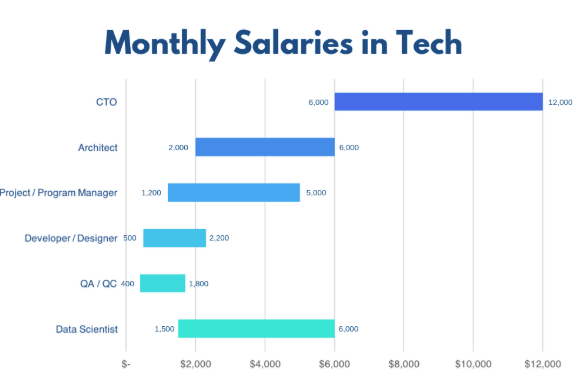What Is Offshore Development? How To Succeed In Offshore Development?
Offshore development is already used by many companies due to its high service quality and cost efficiency. However, there exist a few business leaders and developers who do not have a firm grasp of the benefits and development process of IT outsourcing, while being in two minds about whether it is worth using.
Therefore, in this article, we will explain in detail the definition of offshore development, the advantages and disadvantages, and the precautions, as well as processes, when using offshore development services.
What is Offshore Development?
“Offshore” is a combination of “off” meaning “away” and “shore” meaning “overseas (development)”. In the manufacturing industry, construction industry, IT development industry, etc., it is better to use overseas services with lower material and labor costs than to use domestic services in terms of budget. This is the big attraction of offshore development.
There are two types of offshore development: “contract development” and “laboratory development ”. “Contract development” is to outsource the entire work, and “Lab development” is to secure a dedicated development engineer as a team for a certain period of time. In the case of lab-type development, the development content can be changed during the contract period according to the progress of the project.
Purpose of Using Offshore Development
Companies and organizations use offshore development for two purposes:
① Reduction of Development Costs
The primary reason for domestic companies to use offshore development services is the low cost of development. Labor costs in countries that provide offshore services are lower than those in developed countries, and there are plenty of technically proficient engineers. For that reason, IT offshore service or IT outsourcing service can mitigate the risk of product modification and bring about cost efficiency.
② Excellent Overseas IT Companies and Human Resources

Having access to well-rounded talent engineers is another benefit of IT offshore that should be highlighted. According to Vietnam IT tech-talent report conducted by TopDev, the age dominating this survey is from 20 to 34 years old. Numerous developers started coding early, and about 8.19% of them started coding before 20. At present, the number of developers in Vietnam at a young age accounts for the majority, with 53.97% aged 20 – 29 years old. As a result, clients can make use of dynamic, diligent, and qualified developers.
Apart from this, the number of senior developers with over 5 years of experience accounts for about 30%. Vietnam IT talents ranked 29th in terms of skill value, according to Worldwide in Developer Skills Charts of Skillvalue’s Report 2019 (The only one in the SEA region in the Top 30). Freelancers in IT fields in Vietnam also achieve pride results as being ranked top 2 only after the USA in the World rank of Best Freelancers Survey.
What is The Difference Between Offshore and Nearshore?
Both offshore development and nearshore development are the same in terms of outsourcing software development. However, there is a big difference in the contractor.
Offshore development means outsourcing a development project to another country. Nearshore development, on the other hand, is outsourcing to a developer located in a remote region of the country or a foreign country that is geographically closer to the client’s location.
Let’s discuss the differences between the two in more detail.
| Criteria | Offshore |
Near-shore |
| Definition | Outsourcing overseas. For example, Vietnam and China. | Outsource to domestic companies or countries that are geographically closer to the client’s location. For example, from an office in Tokyo to a company in Saitama Prefecture or Niigata Prefecture. |
| Purpose | Reduce costs while maintaining quality. Lower labor costs in offshore areas can save development budgets. | Cost reduction. Business delays due to time differences and communication problems due to different languages that are common offshore can be eliminated. |
| Place | Foreign countries | Regional cities or countries that are geographically closer to the client’s location |
| Cost efficiency | Substantially cost-efficient | More expensive than offshore and cheaper than in-house development. |
| Linguistic divergence | Have a language discrepancy | None |
| Time Zone | Have a significant time gap | None |
| Difference in Culture | Have a big difference in terms of culture | Almost none |
| Project Management | Frequently communicate with the outsourcing team, and also keep track of their process | Easy |
| Intellectual Property Rights | Risks may arise due to differences in intellectual property laws and regulations. | It is easy to protect intellectual property because it is within the same laws and regulations. |
| Quality of Work | There is a gap depending on the company to consign. | Generally high quality with few hits. |
Advantages and Disadvantages of Offshore Development
Advantages of Offshore Development (Why it Has Become a Trend)
Cost reduction and securing excellent human resources, which are the objectives of offshore development, directly lead to the merits of offshore development. And the benefits of offshore development don’t stop there.
Cost Reduction of Offshore Development
Again, the advantage in terms of cost is that most of the offshore development costs are labor costs, and Southeast Asia, which is selected as a development destination, has considerably lower labor costs than developed countries.
■ Reference: Person-month unit price by offshore development country

Person-month unit price by offshore development country(Offshore Development White Paper 2022 According to (Figures from a survey of 150 BPO companies)).
However, in recent years, due to the improvement in the skills of overseas human resources and the impact of the weaker yen, the benefits of cost reduction have become less apparent. Also, if you choose a development company with only cost as the priority, there is a risk that you will not get the results you expect in terms of technology. Therefore, if you want to proceed with offshore development, you can hope for more reliable results by forming a team with highly skilled engineers and paying a corresponding price.
Excellent Engineers Can be Secured through Offshore Development
As big a benefit as the cost savings is securing excellent overseas IT companies and human resources. Currently, with the rapid globalization and informatization progressing, Japan needs a large number of human resources for the development of IT systems and software.The Ministry of Economy, Trade and Industry announced “Comparative Survey of IT Human Resources by Country, Japan’s IT level is slightly lower than that of Southeast Asian countries.
For example, it is estimated that 400,000 to 800,000 more IT personnel will be required by 2030, and it is believed that Japan alone will not be able to meet this demand. There are quite a few managers who want to hire at least a lead engineer in-house, but it is extremely difficult to hire highly skilled IT engineers at the current stage, where there is a significant shortage of human resources. In order to solve this situation and advance IT development without delay, it will be necessary to secure excellent overseas IT human resources through offshore development.
Shorten Time to Market and Create a Flexible Development System
In offshore development, engineers in Japan and overseas conduct development work simultaneously through the Internet and the cloud. As a result, the delivery time can be significantly shortened.
Offshore development, which secures a large number of excellent human resources and shortens delivery times, simplifies large-scale development and complex projects. In addition, the advantage is that the lead time to bring products to market can be shortened. It will be especially useful for new product development projects and new technology development projects (such as blockchain development, NFT marketplace, WEB3, etc.). Having more offshore developers in the development process speeds development and reduces time to market for products. This allows us to flexibly utilize our resources for larger and more complex projects. Therefore, it is ideal for companies looking to expand their business in a large market across a variety of industries.
Disadvantages of Offshore Development Services (Factors That Are Prone to Failure)
While offshore development has many advantages, it also has disadvantages. Below are some tips on how to avoid failure.
Ineffective Communication
To succeed in offshore development, it is crucial to have English-speaking personnel, particularly in the roles of bridge SE and product manager. If these individuals do not have fluency in English, it is advisable to have an interpreter on hand. Without sufficient human resources and experience in developing for the global market, communication difficulties may arise, potentially leading to project delays or even failure. In such cases, relationships may become strained, leading to a breakdown in the partnership.
There are Time Differences and Cultural Differences
There are differences in how work is done in offshore development countries and client regions, and this can be a disadvantage. What is common sense for English people may seem insane to foreign engineers, and vice versa.
There are cases where things that are customary at offshore development companies do not reach the content and level expected by English people. Then, even if we receive reports that progress management is being carried out appropriately, there are many cases where quality problems are found when we open the lid.
These discrepancies in business practices created the risk of delays in progress and missed deadlines.
=> Communication must be ensured to avoid these problems.
In addition to text-based communication such as e-mail and chat, we diversify communication methods by utilizing video conferencing and voice calls to ensure communication between customers and development teams.
Insufficient Skills of Development Members on the Offshore Side
The lack of skills of offshore development members may also be one of the reasons why offshore development does not go well. Skill shortages have a direct impact on product quality. Therefore, if you do not partner with an offshore company that has excellent bridge SEs and engineers, the success of the project will be far away.
=> To avoid this, the following points should be noted.
- Proper project management: Always monitor the progress of the project, such as the schedule and budget, and promptly deal with any problems that arise.
- Carefully select your development team: When selecting a development team, it is necessary to carefully evaluate the team’s skills, experience, past performance, communication skills, etc. The compatibility between the team and the company in terms of culture (how to proceed with work) is also important.
- Enhancing support from the client side: We can support the development team by quickly providing the necessary information and feedback from the client side. Having the client take responsibility for project management and quality control increases the chances of project success.
- The above two points may seem obvious at first glance. However, there are quite a few cases of failure in choosing an offshore development company, so you need to be very careful.
Preparatory Steps for Offshore Development
Have you ever had the following questions or concerns before requesting an offshore development company?
- “What are the advantages and disadvantages of requesting offshore development?”
- “Can overseas offshore development companies be trusted?”
- “Which offshore company should I choose?”
- “What is the unit price for offshore development?”
- “How to communicate with an offshore development company”, etc.
For domestic companies that want to utilize offshore development but are still hesitant, let’s take a closer look at the 7 steps. In the past, if you are a company that has experienced dissatisfaction or failure using offshore development, please refer to it.
- Unify purpose and awareness within the team
- Clarify roles and responsibilities
- Understanding the advantages and disadvantages of each country
- Selecting a contractor
- Decide contract type and development method
- Create specifications
- Kickoff
The above 7 steps are prerequisites for successful offshore development, but they are still not enough. To further ensure your success, here are some more details on how to proceed with offshore development and some more tips for success.
How to proceed with offshore development and tips for success
How to proceed with offshore development and the reason why it is easy to fail
① Project Start
- Vendor search and selection
- The following methods are often used to find reliable partners for offshore development.
- Introduction of an acquaintance
- Exhibition
- Seminar / Webinar
- Search on Google
- Matching site
The most commonly used method is to search for keywords such as “country system development” and “offshore development company” on Google, Yahoo, etc.
The second is the pattern of participating in IT exhibitions and seminars. Not only can you find out more about the services and products of each offshore company, but you can also ask for specific advice. Direct contact will help you find a partner that fits your company’s needs and culture.
When examining partners,
- I want you to show me the achievements of ○○
- Do you have a track record of ○○?
- How many years of offshore development experience do you have?
Please be specific about your track record and experience…
At that time, if there is a company that casually answers that they can do anything, it is better to suspect that it is suspicious.
It is also important to check your communication skills. Please check carefully whether you can communicate in English and what your language level is.
We recommend that you consider at least 5 to 6 companies as candidates.
② Specification Decision
Specifications are the core of any project that must be created before an order can be placed. Basically, it is created by the ordering party who requests the development.
For example, in the case of NFT game development,
- Which game will be converted to NFT
- Do you want to convert an existing game into NFT or create a new NFT game?
- What kind of function do you want to have?
List everything you need.
After thoroughly discussing “what you want to create” within the company, it is an essential step to ask and consult with offshore development companies.
Let’s drop the following 3W1H as materials in advance.
- WHY: Background, reason for wanting to make, etc.
- WHAT: What do you want to make? Is the scope of development limited to the web? An app too?
- WHEN: Start time, delivery date
- HOW MUCH: What is your budget? → We recommend creating a request for proposal (RFP).
If it is not described in the specification, it is highly likely that it will not be implemented in the product. Realize that the more detailed and clear the content is, the more accurately the developer will understand your intent.
In order to create an easy-to-understand specification, the following points should be devised.
- Illustrated/image insert
- Prepare a sequence diagram
- description of the details
Based on the specifications completed in this way, the project manager (the person in charge of the project) and engineers proceed with development.
③ Development Implementation
The active participation of the client at this stage is very important. Set up regular meetings to check progress.
In order to lead the project to success, not only the level of the offshore company but also the participation and follow-up of the client are essential. It is strictly prohibited to throw a round at an offshore company.
In offshore development, it is very important to communicate with the requesting side and the overseas team. Moreover, the time difference and public holidays differ from country to country. Therefore, make sure that you both agree on progress confirmation, meeting times, whether you can work on holidays, etc.
In particular,
- Hold regular weekly meetings to review the progress
- Exchange opinions while operating the screen
- Fine-tuning: Frequent mutual discussions about whether the progress of the project is good as it is, whether there are any other problems, points for improvement, changes to the delivery date, etc.
- Communicate at least 8 hours a week
This way, if something goes wrong, it can be resolved immediately, reducing the risk of delays.
④ Test/Repair
This is the final stage of product completion.
- Whether there is any problem
- Check if a fix is needed
Testers in the development team perform tests after predicting possible cases to see if the product operates smoothly as requested by the client. If there is a problem and there is a request for additional functions or corrections, it is basic to discuss and respond at this stage.
In order to complete the project efficiently, it is important for the person in charge of the offshore development company and the client to check the operation together.
⑤ End of Project
If all problems are solved in the test stage, the function is updated and checked again, and there is no problem, it will be delivered. Also, in the case of a contract, we will do it until release after this. On the day of release, the team should be on standby to deal with any trouble.
After the release, you will be under warranty, but you should be aware of the following points.
- The team disbands after the release, so that quick fixes can be difficult
- Defects outside the scope of the estimate cannot be handled free of charge, even within the warranty period.
The ideal way to proceed differs depending on the scale and purpose of the project. In that respect, it is important to reach an agreement with the offshore development company down to the smallest details, understand the entire process, and maintain constant communication while carefully proceeding to the end.
5 Best Countries for Offshore Development
Offshore development has gained popularity as a cost-saving solution in many cases. In 2023, the focus is expected to be particularly on countries with strong track records in offshore development. So, next, I will elaborate on the five countries that are suitable for offshore development.
Ranking of offshore development contractors by country
Vietnam
In Vietnam, the IT industry is growing remarkably, partly due to substantial investment from the government. The government has implemented a large-scale educational program to develop a workforce with IT skills and introduced tax incentives to encourage foreign companies to enter the country. Through these measures, Vietnam has become one of the most advanced offshore development countries.
- Person-month unit price: Approximately 250,000 to 350,000 yen in English yen
- Official language: Vietnamese. English and English are often used in the business scene, and many IT engineers can speak both English and English.
- Level of IT personnel: High
- Advantages: Labor costs are low, and information technology education at universities is thriving. It is politically stable and has a peaceful business environment. Since the national character is calm, communication is smooth, and you can expect smooth business progress.
- Cons: Slightly inefficient compared to Western countries. There is also the risk that the project will be delayed more than expected.
China
It boasts the world’s largest population and is also a leader in the IT outsourcing market. In recent years, it has been focusing on the latest technologies such as cloud computing, big data, artificial intelligence, etc., which are highly attractive to programmers and developers.
- Person-month unit price: 350,000 to 550,000 yen
- Official language: Chinese
- Level of IT personnel: High
- Strengths: Suitable for large-scale projects, high technical capabilities and productivity, and many experts.
- Cons: Communication barriers and intellectual property issues.
India
It is an advanced offshore development country that is popular with many companies. Companies all over the world have a number of development teams in India. We have high IT skills, and English is used as a common business language, so there is no need to worry about communication.
- Person-month unit price: 300,000 to 600,000 yen
- Official language: English
- Level of IT personnel: High
- Strengths: High technical ability and productivity. Communication is easy because English is the official language. You can take advantage of the time difference (3 and a half).
- Cons: Communication barriers due to cultural differences. It is difficult to secure human resources due to the large population.
Philippines
English is the official language. There are many cultural similarities with the United States, and many companies use it for customer support and application development purposes.
- Person-month unit price: 250,000 to 300,000 yen
- Official language: English
- Level of IT personnel: Medium
- Pros: English is the official language, so communication is easy. You can take advantage of the time difference. Low cost.
- Disadvantages: Due to varying technical capabilities, it is necessary to select appropriate companies. Communication barriers due to cultural differences.
Myanmar
It is one of the emerging markets where offshore development has become more popular in recent years. It has strengthened government support for IT development, has a rich skill set of programmers, and is advantageous in terms of cost.
- Person-month unit price: 180,000 to 250,000 yen
- Official language: Burmese
- Level of IT personnel: Low
- Pros: Low cost. The government is actively fostering the IT industry.
- Disadvantages: Lack of English proficiency and uneven quality of IT human resources, so it is necessary to select appropriate companies.
Each of these five countries has an excellent track record and is expected to be chosen by more companies as offshore partners in 2023.
Read more: ODC and Fixed Cost Contract: Pros and Cons Explained
Summary
Relipa prides itself on providing exceptional IT solutions to small and medium-sized enterprises and English companies lacking experience in offshore development. The company’s founder graduated from Hanoi University of Technology, which is recognized as the top science major in Vietnam, and possesses advanced English language skills and a deep understanding of global culture. Relipa’s core focus is on “securing resources” and developing IT human resources, as the company believes that investing in human resources is a key factor in meeting the latest technology trends and delivering products that satisfy customers. What sets Relipa apart from other offshore companies is that the general manager is involved in every project from start to finish, providing clients with personalized advice and guidance. Relipa’s offshore development team is also available for dispatch to Japan if needed, and the company follows a “report, contact, and consultation” policy to ensure the timely and effective resolution of any issues that may arise.
If you are seriously considering offshore development in the future, please feel free to contact us.





